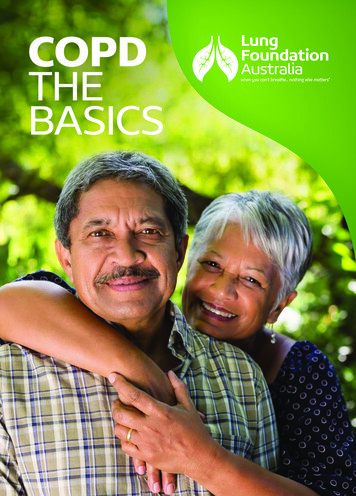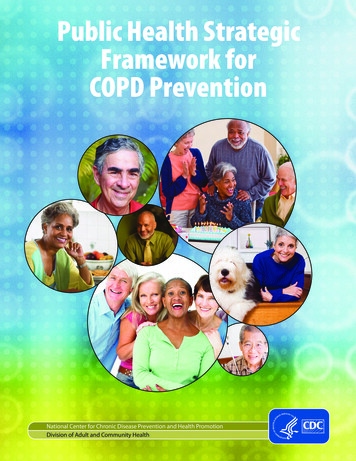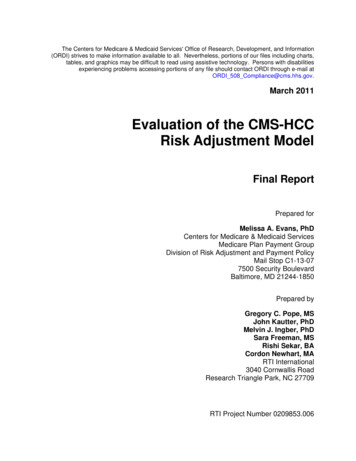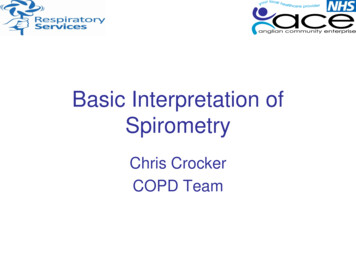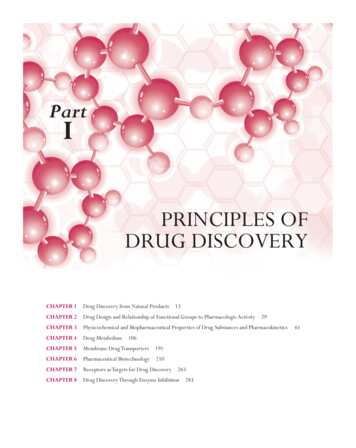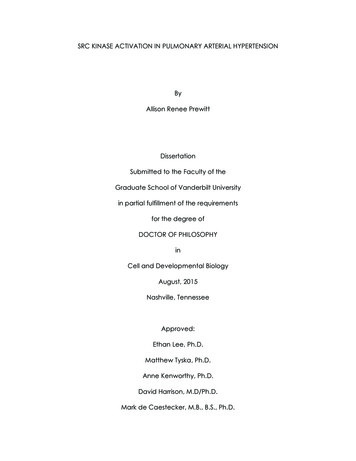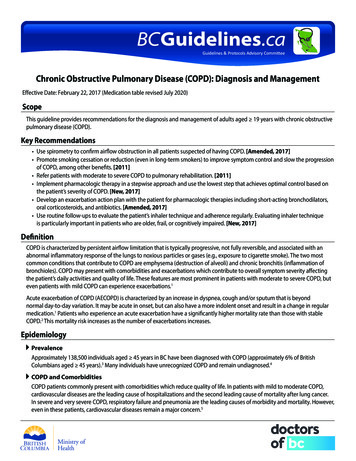
Transcription
Guidelines & Protocols Advisory CommitteeChronic Obstructive Pulmonary Disease (COPD): Diagnosis and ManagementEffective Date: February 22, 2017 (Medication table revised July 2020)ScopeThis guideline provides recommendations for the diagnosis and management of adults aged 19 years with chronic obstructivepulmonary disease (COPD).Key Recommendations Use spirometry to confirm airflow obstruction in all patients suspected of having COPD. [Amended, 2017] Promote smoking cessation or reduction (even in long-term smokers) to improve symptom control and slow the progressionof COPD, among other benefits. [2011] Refer patients with moderate to severe COPD to pulmonary rehabilitation. [2011] Implement pharmacologic therapy in a stepwise approach and use the lowest step that achieves optimal control based onthe patient’s severity of COPD. [New, 2017] Develop an exacerbation action plan with the patient for pharmacologic therapies including short-acting bronchodilators,oral corticosteroids, and antibiotics. [Amended, 2017] Use routine follow-ups to evaluate the patient’s inhaler technique and adherence regularly. Evaluating inhaler techniqueis particularly important in patients who are older, frail, or cognitively impaired. [New, 2017]DefinitionCOPD is characterized by persistent airflow limitation that is typically progressive, not fully reversible, and associated with anabnormal inflammatory response of the lungs to noxious particles or gases (e.g., exposure to cigarette smoke). The two mostcommon conditions that contribute to COPD are emphysema (destruction of alveoli) and chronic bronchitis (inflammation ofbronchioles). COPD may present with comorbidities and exacerbations which contribute to overall symptom severity affectingthe patient’s daily activities and quality of life. These features are most prominent in patients with moderate to severe COPD, buteven patients with mild COPD can experience exacerbations.1Acute exacerbation of COPD (AECOPD) is characterized by an increase in dyspnea, cough and/or sputum that is beyondnormal day-to-day variation. It may be acute in onset, but can also have a more indolent onset and result in a change in regularmedication.1 Patients who experience an acute exacerbation have a significantly higher mortality rate than those with stableCOPD.2 This mortality risk increases as the number of exacerbations increases.EpidemiologyPrevalenceApproximately 138,500 individuals aged 45 years in BC have been diagnosed with COPD (approximately 6% of BritishColumbians aged 45 years).3 Many individuals have unrecognized COPD and remain undiagnosed.4COPD and ComorbiditiesCOPD patients commonly present with comorbidities which reduce quality of life. In patients with mild to moderate COPD,cardiovascular diseases are the leading cause of hospitalizations and the second leading cause of mortality after lung cancer.In severe and very severe COPD, respiratory failure and pneumonia are the leading causes of morbidity and mortality. However,even in these patients, cardiovascular diseases remain a major concern.5
DiagnosisWhile a diagnosis is based on a combination of medical history and physical examination, it is the documentation of airflowlimitation using spirometry that confirms the diagnosis.Consider a COPD diagnosis for a patient 40 years of age who has:1) Respiratory symptoms, including: dyspnea (progressive, persistent and worse with exercise); chronic cough; and increased sputum production.AND 2) One of the following: history of exposure to cigarette smoke; history of environmental/occupational exposure to smoke, dust or gas/fumes; frequent respiratory infections; or family history of COPD.Consider alternative diagnoses. Asthma and asthma-COPD overlap syndrome (ACOS) are the two primary differential diagnosesto rule out (see Table 1 for features). Other alternative diagnoses include: heart failure (e.g., older patients, when breathlessness is out of proportion to spirometry results; measuring B-type natriureticpeptide (BNP) levels may help in diagnosing heart failure); and tuberculosis (e.g., high risk populations – aboriginal, foreign born).Table 1. Typical features of asthma, COPD and ACOSFeatureAsthmaCOPDACOSAge of onsetChildhoodAge 40 yearsPattern of respiratory symptomsVary over time, limit activity, worseduring night or early morning;triggered by exercise, laughter,exposure to allergens, respiratoryillnessChronic and continuous, particularly Symptoms (including exertionalduring exercise, with “better” ordyspnea) are persistent but“worse” daysvariability may be prominentLung functionRecord of variable airflow limitation(e.g., BD reversibility, AHR)FEV1 may improve with therapy butpost-BD FEV1/FVC 0.7 persistsAirflow limitation not fully reversiblebut often with current or historicalvariabilityLung function betweensymptomsMay be normalPersistent airflow limitationPersistent airflow limitationPast/family historyAllergies and childhood asthmaExposure to noxious particles andgases (e.g., tobacco)Asthma diagnosis (current/previous), allergies and/or noxiousexposuresTime courseImproves spontaneously or withtreatment, but may result in fixedairflow limitationSlowly progressive over yearsdespite treatmentSymptoms typically persistent butsignificantly improved by treatment;progression is usual and treatmentneeds are highChest x-rayNormalHyperinflation and other changesof COPDSimilar to COPDExacerbationsOccur but the risk can beconsiderably reduced by treatmentReduced by treatment.Comorbidities contributeto impairmentMore common than in COPDand are reduced by treatment;comorbidities can contributeto impairmentAge 40 years but may havesymptoms in childhoodAdapted from: Global Initiative for Chronic Obstructive Lung Disease (GOLD). Global Strategy for the Diagnosis, Management, and Prevention of Chronic ObstructivePulmonary Disease, Updated 2016.Abbreviations: ACOS asthma-COPD overlap syndrome; AHR airway hyperresponsiveness; BD bronchodilatory; COPD chronic obstructive pulmonary disease;FEV1 forced expiratory volume in 1 second; FVC forced vital capacity.2BCGuidelines.ca: Chronic Obstructive Pulmonary Disease (COPD): Diagnosis and Management (2017)
Investigations or TestsSpirometrySend ALL patients suspected of having COPD for confirmation of the diagnosis by spirometry. A COPD diagnosis isconfirmed when a post-bronchodilator spirometry measurement indicates that there is airflow limitation which is not fullyreversible (FEV1 / FVC ratio 0.7 or FEV1 / FVC lower limit of normal values). A FEV1 predicted measurement is not neededfor diagnosis, but is useful in the assessment of severity.Timely access to spirometry may be a challenge in rural and remote communities, but should remain a reasonable goal.Assuming access to spirometry can occur in a reasonable time frame, a referral to a specialist should not be done beforeobjectively confirming the diagnosis of COPD.Borderline Spirometry ResultsThere is some controversy regarding the fixed cut-off of 0.7 for FEV1 / FVC ratio versus using lower limit of normal values.There is some evidence that a fixed ratio can lead to over diagnosis in older populations, under diagnosis in young people,and a gender difference.6 Recent evidence also suggests that some current or former smokers may have symptoms of COPDwithout meeting spirometric criteria for a COPD diagnosis.7 For borderline results, repeat spirometry after a few months.Consider alternative diagnoses for all patients with borderline spirometry results or if breathlessness is out of proportionto spirometry results. If FEV1 response to bronchodilator is: 400 mL, strongly consider asthma or ACOS. 400 mL (but 200 mL and 12% of FEV1), consider asthma or ACOS depending on the history and pattern of symptoms(see Table 1 above).?Chest X-rayA chest x-ray is not helpful in diagnosing COPD. A chest x-ray that shows hyperinflation may suggest COPD, but the diagnosisrequires objective confirmation with spirometry. A chest x-ray may be useful, and should be documented, if there are concernsabout other significant comorbidities (e.g., heart failure, tuberculosis, pneumonia).?Other Pulmonary Function TestsOther pulmonary function tests (e.g., body plethysmography, diffusing capacity, arterial blood gas measurement) are notrequired for a COPD diagnosis, but may be helpful in assessing the severity of COPD or when considering alternative diagnoses.For example, a body plethysmography may help in the assessment of severity of COPD, but is not essential.Peak flow meter readings may help rule out asthma, but their usefulness in assessing COPD remains unclear.Assessment of COPD SeverityOnce the diagnosis is confirmed, determine the level of COPD severity (see Table 2) by using the patient’s: current level of symptoms; FEV1 predicted; risk of exacerbation; and presence of comorbidities.Assessment ToolsTo assist in determining the current level of a patient’s symptoms, use a tool such as the COPD Assessment Test (CAT) (website:www.catestonline.org). The MRC Breathlessness/Dyspnea Scale (website: rresearchers/mrc-scales) may also be useful.BCGuidelines.ca: Chronic Obstructive Pulmonary Disease (COPD): Diagnosis and Management (2017)3
Table 2. Levels of severity in COPD 1, 6COPDSeverityMildModerateSevereVery severeSymptoms Breathlessness on moderate exertion Recurrent chest infections Little or no effect on daily activities Increasing dyspneaBreathlessness walking 100 m on level groundIncreasing limitation of daily activitiesCough and sputum productionExacerbations requiring corticosteroids and/orantibiotics Dyspnea on minimal exertionDaily activities severely curtailedExpiring regular sputum productionChronic coughFEV1(% predicted)History ofexacerbationsComorbidities 8050 – 7930 – 49Frequency increaseswith severityExist across all severity levels(e.g., cardiovascular disease,skeletal muscle dysfunction,metabolic syndrome,osteoporosis, anxiety ordepression, lung cancer,peripheral vascular diseaseand sleep apnea) 30ManagementThe therapeutic goals of COPD management include: 8 to alleviate breathlessness and other respiratory symptoms that affect daily activities; to prevent and reduce the frequency and severity of acute exacerbations; to minimize disease progression and reduce the risk of morbidity/mortality; and to optimally manage comorbidities (if present) to reduce exacerbations and COPD symptoms related to comorbidities.When developing the patient’s therapeutic goals and a management plan, consider: using a shared decision-making approach with the patient, taking into account patient preferences and capabilities(e.g. cognitive ability, language barriers); including a chronic disease and self-management approach facilitated by health professionals, as it can significantly improvehealth status and reduce hospital admissions for exacerbations by 40%; 9 using non-pharmacological and pharmacological interventions based on the individual patient’s level of severity, simplifying the medication regime in the context of other conditions and treatments, particularly in the elderly; and reviewing the treatment approach regularly to eliminate medications that are not improving symptoms or reducingexacerbations.1. Lifestyle and Self-ManagementThe patient’s understanding of, and participation in, optimal care may improve coping skills and quality of life and reduce thelikelihood of hospitalization from COPD. Educate the patient and their family or caregiver about lifestyle and self-managementstrategies – refer to Associated Documents: Resource Guide for Patients.Help the patient identify resources and a support team (e.g., educator, pharmacist, nurse, dietitian). Refer to Associated Documents:COPD Management Services Referral Form for Vancouver Coastal Health, Providence Health Care and Fraser Health. Refer to healthauthorities for referral services in other areas.Smoking CessationPromote smoking cessation or reduction (even in long-term smokers) and avoidance of second-hand smoke. Smoking is themain cause of COPD and the main contributing factor for disease progression. Smoking cessation has immediate benefitsincluding: 1) improving symptom control, 2) slowing progression of disease, 3) improving cardiovascular outcomes, and4) reducing long-term risk of lung cancer. For assistance in quitting smoking, refer patients to QuitNow at HealthLinkBC by telephone at 8-1-1 or website:www.quitnow.ca. For more information on effective pharmacological aids for smoking cessation, refer to the BC Smoking Cessation programwebsite: es.ca: Chronic Obstructive Pulmonary Disease (COPD): Diagnosis and Management (2017)
Physical ActivityEncourage exercise and a more active lifestyle. Remaining active despite symptoms of shortness of breath must remain apriority for all patients with COPD.Pulmonary Rehabilitation and Respiratory ServicesModerate to severe COPD patients should be referred to a pulmonary rehabilitation program (where available) and tocommunity respiratory services. Home and Community Care programs offered by health authorities include home visitsby a respiratory therapist for COPD patients, among other things. To find a program in BC, contact HealthLink BC at 8-1-1, refer to the Referral Resources section below, or contact healthauthorities regarding local services. A list of pulmonary rehabilitation programs in BC is available at rograms-contacts/.Diet ConsiderationsEnsure adequate diet to maintain body mass index in the “normal” range (20 to 25 kg/m2), as it is essential in limiting diseaseprogression and reducing morbidity and mortality related to COPD. Reduced body mass index (and in particular anorexia) isone of the most important risk factors for COPD progression.Air QualityEncourage patients to stay indoors when air quality is poor, as air quality may have a significant effect on COPD symptoms andthe risk of exacerbations.Oxygen TherapyThe goal of oxygen therapy is to maintain PaO2 60 mmHg or SpO2 90% at rest, on exertion and during sleep. (PaO2 partial pressure of oxygen in arterial blood, SpO2 % oxygen saturation). Oxygen therapy may be a useful addition to increaseexercise capacity. Refer to Appendix C: BC Home Oxygen Program Medical Eligibility, or to health authorities for local criteriaregarding coverage.ImmunizationIndividuals with COPD are at higher risk of complications of influenza and pneumococcal infection. While the polysaccharidepneumococcal vaccine may provide some protection against morbidity for patients with COPD, the evidence remains limited.10Encourage an annual influenza vaccine, which is provided free of charge in BC to adults with COPD – refer to ctivated-influenza-vaccine.The pneumococcal polysaccharide vaccine is recommended, and provided free of charge in BC, for adults with COPD.Some patients with specific comorbidities or undergoing certain treatments (e.g., chemotherapy) may also benefit fromthe pneumococcal conjugate vaccine. Some international COPD guidelines also suggest a booster of the pneumococcalpolysaccharide vaccine at 5-10 years. Refer to HealthLink BC (website: lpolysaccharide-vaccine) and Immunize Canada (website: aspx).Advance Care PlanningInitiate advance care planning discussions for all patients with a diagnosis of COPD. Advance care planning should be tailoredto the needs of the patient along the disease trajectory, and should incorporate the patient’s values and goals, indicatepotential outcomes, and identify health care professionals involved in care. The advanced care plan is also an opportunity toidentify the patient’s alternate substitute decision maker or representative. For assistance, the Ministry of Health’s advance care planning guide My Voice – Expressing My Wishes for Future Health CareTreatment is available at website: gov.bc.ca/advancecare.BCGuidelines.ca: Chronic Obstructive Pulmonary Disease (COPD): Diagnosis and Management (2017)5
2. Pharmacologic ManagementWhen developing the patient’s therapeutic goals and pharmacologic management plan, individualize the plan based on thepatient’s symptoms, exacerbation history, response to treatment and their risk of adverse effects. For more information onspecific medications, refer to Appendix A: Prescription Medication Table for COPD.Inhaled MedicationsMany new inhaled medications, including fixed dose combinations, have been introduced in recent years. It isrecommended to: Ensure that drug classes are not duplicated when initiating or modifying drug therapy. Evaluate the patient’s inhaler technique and adherence regularly, as up to 90% of patients use their device incorrectly.Evaluating inhaler technique is particularly important in patients who are older, frail, or cognitively impaired. Forinformation on how to use different inhalers, refer patients to website: er. Consider prescribing a spacer for metered dose inhalers; however it should be noted that spacers require regularmaintenance and cleaning to ensure optimal use.Bronchodilator medications are central to symptom management in COPD, and should be prescribed on an as-needed orregular basis to prevent or reduce symptoms.1Stepwise Approach to Pharmacologic TherapyImplement pharmacologic therapy in a stepwise approach and use the lowest step that achieves optimal control based onthe patient’s severity of COPD (see Figure 1). When assessing for the next step, consider exertional dyspnea, functional status,history of exacerbations, complexity of medicines or devices, patient preference (e.g., cost and ability to adhere to treatmentplan) and occurrence of adverse effects. Refer to Appendix A: Prescription Medication Table for COPD for information on dosing,drug costs, Pharmacare coverage, and therapeutic considerations.Figure 1. Stepwise approach to pharmacologic management based on severity of COPDned obasthePDf COoyeritsevtrolconlaSTEP 3: TO PREVENT EXACERBATIONSptimes oveiht acTriple TherapythapetsLAMA LABA ICStselowehtUseCH:ASTEP 2: FOR SYMPTOM RELIEF ANDLABA SIPWSTELABA or LAMAMonotherapySTEP 1: FOR SYMPTOM RELIEFSABA SAMACombination TherapyTIP: LABA LAMAshould not be usedconcurrentlySABA or SAMAMonotherapyMild COPDSevere COPDAbbreviations: COPD chronic obstructive pulmonary disease; ICS inhaled corticosteroid; LABA long-acting beta2-agonist; LAMA long-acting antimuscarinic antagonist;SABA short-acting beta2-agonist; SAMA short-acting muscarinic antagonist.6BCGuidelines.ca: Chronic Obstructive Pulmonary Disease (COPD): Diagnosis and Management (2017)
Step 1: SAMA or SABA Therapy – For symptom relief For all symptomatic patients, prescribe a short-acting inhaled bronchodilator (short-acting beta2-agonist (SABA) or shortacting muscarinic antagonist (SAMA) for acute, short-term relief of shortness of breath.6 For those with moderate to severe COPD, SAMA or SABA monotherapy is recommended. Limited evidence suggests thatSAMA reduces the risk of AECOPD, improves quality of life and lung function, and may be better tolerated, as comparedto SABA monotherapy.10, 11 If symptoms are not well controlled with monotherapy, consider combination therapy of SAMA SABA.10Step 2: Additional LAMA or LABA Therapy – For symptom relief and to prevent exacerbations At the next step in symptom management, consider monotherapy with a long-acting beta2-agonist (LABA) or a long-actingantimuscarinic antagonist (LAMA). Limited evidence suggests LAMA may reduce the number of moderate and severeexacerbations compared to LABA therapy.12,13 Given the limited evidence, consider a substantial trial of LAMA, followedby a LABA (or vice versa), then continue with the patient’s preferred therapy.13 If monotherapy does not provide adequate relief of symptoms, consider a combination of LABA LAMA, which providesslightly better quality life and lung function over either therapy alone, and reduces exacerbations compared to LABAalone.14 Fixed dose combination inhalers of LABA with a LAMA are available,8 and have been shown to be superior to inhaledcorticosteroid (ICS) LABA combination in reducing symptoms and preventing exacerbations in COPD.15 Ipratropium bromide/Atrovent (a SAMA) and a LAMA should not be used concurrently.6,10Step 3: Triple Therapy – To prevent exacerbations For those with moderate to severe COPD and repeated exacerbations (e.g., FEV1 50% predicted and 2 exacerbations inthe past 12 months), a triple combination therapy of a LABA ICS and LAMA is recommended.6 Fixed dose combination inhalers of an ICS with a LABA are available; if a combination inhaler is initiated, discontinue the useof the single agent LABA inhaler. 6 The use of ICS with COPD remains controversial (see Controversies in Care section below). ICS monotherapy is notrecommended, and if used in combination therapy, use the lowest possible dose.Treatment of Acute Exacerbations of COPD (AECOPD)Acute exacerbations are characterized by sustained (e.g., 48 hours or more) worsening of shortness of breath and coughing,usually with increasing sputum volume. The most common cause of AECOPD is a viral or bacterial infection; however, thereare a number of non-infectious causes of exacerbations including: pleural effusion, heart failure, pulmonary embolism, andpneumothorax.Severe AECOPD complicated by acute respiratory failure is a medical emergency and the patient should seekimmediate treatment. However, more than 80% of exacerbations can be managed on an outpatient basis with pharmacologictherapies including short-acting bronchodilators, oral corticosteroids, and antibiotics.1 Develop an exacerbation action planwith the patient (see Associated Document: COPD Flare-up Action Plan). Note that there are some populations for which awritten action plan may not be appropriate, including patients with cognitive disabilities, patients who cannot adequatelyfollow instructions, and patients with significant comorbidities that might increase the risk of steroid-adverse effects.16Pharmacologic therapies may include:1) short-acting bronchodilator for initial treatment of acute exacerbations Adequate doses of bronchodilator (e.g., salbutamol 400 to 800 mcg [4 to 8 puffs]) delivered via metered dose inhalerwith a spacer is equivalent to 2.5 mg by nebulizer and is as effective. Administer salbutamol frequently (up to everycouple of hours) and titrate to response.62) oral corticosteroids in most moderate to severe COPD patients1 A dose of 40 mg of prednisone per day for 5 days is an appropriate dose.17 However, a dose of 50 mg of prednisoneper day is often used in Canada because of its availability in a single tablet. Lower doses may need to be used,especially in the presence of diabetes mellitus. Evidence suggests that systemic corticosteroids in AECOPD shorten recovery time, improve lung function, improvearterial hypoxemia, and reduce the risk of early relapse, treatment failure, and duration of hospitalization.1BCGuidelines.ca: Chronic Obstructive Pulmonary Disease (COPD): Diagnosis and Management (2017)7
There is a well-powered randomized controlled trial comparing 5 versus 14 days of oral corticosteroids showingsimilar efficacy.17 For most patients, tapering of the corticosteroid dose should not be necessary.1, 6 Systemic corticosteroids have not been shown to reduce AECOPD beyond the initial 30 days of an exacerbation andthe long-term use of systemic corticosteroids is not recommended as the risk of adverse events far outweighs anypotential benefits.Bronchodilators and corticosteroids may be administered by nebulizer, metered-dose inhaler, or dry powder inhaler. While allof these devices are appropriate for treating COPD exacerbations, each has advantages and disadvantages. In choosing a drug/device combination, take into account the patient’s cognitive and physical ability, ease of use, convenience, cost, and patientpreferences.183) antibiotic treatment Patients presenting with symptoms and risk factors for bacterial infection may benefit from antibiotic treatment. Whilestudies have shown large and consistent benefit from antibiotic use among COPD patients admitted to the ICU, theevidence for their use in patients with mild to moderate exacerbations is less clear. 19 However, the totality of datasuggests that for patients with moderate to severe exacerbations, antibiotics are effective in reducing relapse ratesin COPD. 20 Refer to Appendix B: Antibiotic Treatment Recommendations for Acute Exacerbations of COPD.Controversies in CareCardiovascular Risk and IpratropiumA small increase in cardiovascular events has been reported with the regular use of ipratropium in COPD patients.1 However,this result has not been validated by a large randomized controlled trial (RCT) and further study is required.21Cardiovascular Risk and TiotropiumOne large, long-term clinical trial showed no evidence of cardiovascular risk when tiotropium was added to other standardtherapies.21Mortality Risk and TiotropiumA meta-analysis suggested that tiotropium delivered via the Respimat inhaler was associated with a significantly increasedrisk of mortality when compared to placebo. However, in a large RCT comparing tiotripium via Respimat to tiotropium viaHandiHaler (dry powder inhaler), no differences in mortality or exacerbation rates were shown.22Use of Inhaled CorticosteroidThe effects of ICS on pulmonary and systemic inflammation in COPD remain controversial,1 and the use of ICS in COPDmanagement is limited to specific indications: ICS monotherapy has very modest effects on symptoms and exacerbations and its limited benefits are outweighed bypotential adverse effects, including increased risk of pneumonia. As such, ICS monotherapy is not recommended. Triple therapy of a LABA, ICS and a LAMA has limited evidence to suggest it improves lung function and quality of life.1However, triple combination may be useful for the management of patients with moderate to severe COPD who continueto experience repeated exacerbations despite use of LABA/LAMA combination therapy or who have been recentlyhospitalized with severe COPD exacerbation.23 As such, triple therapy is recommended for this indication.Use of MethylxanthinesThe exact physiologic benefits of methylxanthines (xanthine derivatives, such as theophylline) remain unknown. There islimited data on the duration of action for both conventional release and extended release xanthine preparations. In thestudies that have shown efficacy of theophylline in COPD, extended release formulations were used.1 The use of theophyllinein select patients with persistent symptoms was recommended in the previous version of this guideline (2011), and continuesto be recommended by a number of international guidelines.1, 6 However, a Cochrane Review recommended against the useof methylxanthines for COPD exacerbations given that the evidence of potential benefit was modest and inconsistent, whilepotential adverse effects were significant.248BCGuidelines.ca: Chronic Obstructive Pulmonary Disease (COPD): Diagnosis and Management (2017)
Use of Oral N-acetylcysteine (NAC)The routine use of NAC in the management of COPD remains controversial due to conflicting evidence and methodologicalissues in the trials.25Indications for ReferralRefer patient to a specialist in cases where: the diagnosis is uncertain; a patient is 40 years with COPD and limited smoking history, or has severe symptoms and disability which isdisproportionate to their lung function; there is evidence of an alpha-1 antitrypsin (A1AT) deficiency (e.g. early onset of emphysema or COPD, unexplained liverdisease, family history); there are signs and symptoms of hypoxemic or hypercarbic respiratory failure; there are severe or recurrent exacerbations and treatment failure; the patient has severe COPD and disability requiring more intensive interventions; a more intensive comorbidity assessment and management is required; a patient is frail and may benefit from multidisciplinary or comprehensive geriatric assessment, and/or there is difficulty in assessing home oxygen or sleep disorders.Family physicians and nurse practitioners in participating areas may consider contacting the Rapid Access to ConsultativeExpertise (RACE) phone line to speak directly with a specialist, including respirologists, or accessing referral services throughPathwaysBC.ca. Refer to the Referral Resources section below.Ongoing ManagementFollow-up CareModify therapeutic goals and management plans as appropriate. Use routine follow-ups to ask about and monitor the patient’skey clinical indicators, including: lung function; changes in symptoms (e.g. any improvement since starting/changing treatment; changes in level of breathlessness,activity level, sleep quality, etc.); exacerbation history (frequency, severity) and review of the Flare-Up Action Plan (website: bc-guidelines/copd action plan.pdf); management of comorbidities (if present); and pharmacologic therapy adherence and inhaler technique.Palliative CareMaking decisions about the intensity of palliative care is a highly individualized process and requires continuous review asCOPD progresses. Once the decision to initiate palliative care is made, the goal of therapy is to manage symptoms, reducetreatment burden, and maximize comfort and quality of life. This may include providing support for the patient’s family andcaregivers. Consider referral to
heart failure (e.g., older patients, when breathlessness is out of proportion to spirometry results; measuring B-type natriuretic peptide (BNP) levels may help in diagnosing heart failure); and tuberculosis (e.g., high risk populations - aboriginal, foreign born). Table 1. Typical features of asthma, COPD and ACOS Feature Asthma COPD ACOS

